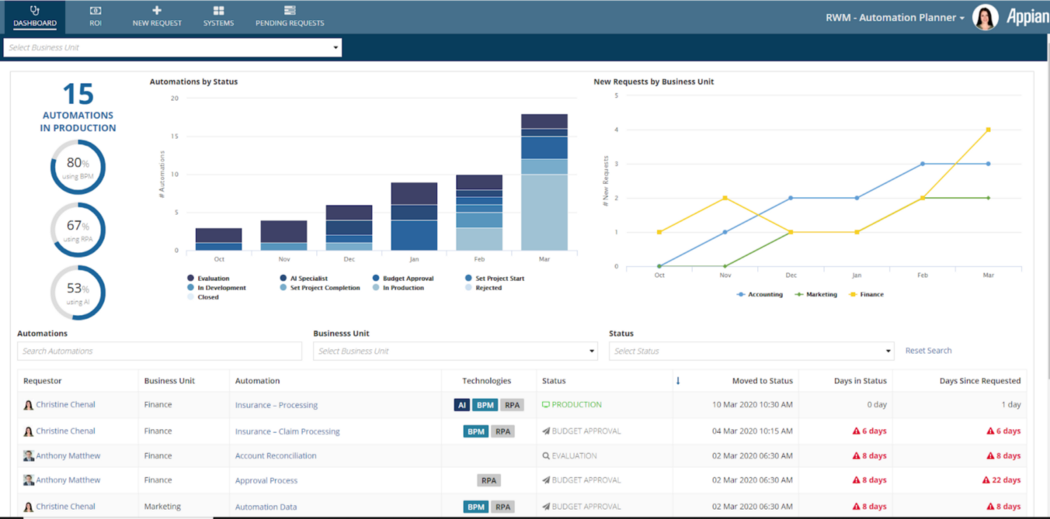As only 13% of companies can scale their RPA use cases, enterprise automation today faces many hurdles.
So what if you could automate the discovery of automation opportunities? This is the promise of hyperautomation.
By analyzing and mining business processes, these technologies can detect easily automatable tasks and generate AI-based bots that can replicate them.
Hyperautomation-based platforms ease the implementation of automation in any big organization. But how do they work, and what do they bring to your automation projects?
Find out here.
What is hyperautomation?

Automation in big companies faces many challenges, as it involves wide-scale projects across all departments. To complete these projects, you need to analyze and redesign each department’s workflows one by one.
Hyperautomation takes instead a more holistic approach to automation, by considering the entire cycle of the automation projects. It helps companies scale up their implementation process with maximum results, by optimizing the search for automation opportunities and workflow modeling within the whole organization.
As a practice coined by the high-tech consulting firm Gartner, the purpose of hyperautomation is to combine different types of technologies to lead automation projects with efficiency and long-term value.
It means leveraging various types of technologies such as:
- RPA: platforms that generate digital bots replicating your repeatable and time-intensive tasks.
- Process mining & discovery: features that help you analyze workers’ workflows and seize automation opportunities according to their ease of automation/benefit ratio.
- AI & Machine Learning: augmented process intelligence that fits each company’s needs.
- OCR: tools that can read unstructured documents to automate data collection tasks.
- DTO: dynamic models of your organization’s processes that help you analyze your workflows and plan your automation projects.
- Advanced analytics: tools to extract and analyze in-depth performance data from your automation processes.
The benefits of hyperautomation
This holistic approach to automation aims to address many of the issues that automation-seeking companies face. It promises :
- Agile implementation processes
- Easier to assess the performance and ROI of automation projects
- Shorter deployment time
- Better acceptance among employees
- Less need for IT teams
What are the concrete applications?
Hyperautomation can have a big impact on crucial departments and essential use cases for companies:
- Customer service: you can analyze your customers’ conversations to determine when bots can drive the talk and when human workers should intervene.
- Finance: you can automate your accountants’ work by analyzing their task structures (applications usage, data entry, and process completion) and relying on it as a template to generate a predefined bot.
- Insurance: you can scale your insurance claims automated processing by making your OCR capabilities grow so that it can read textual and unstructured data of all kinds.
- Operations: You can troubleshoot your missed or overdue order deliveries by mapping your operators’ tasks and your CRM and ERP data. From that analytics, you can then figure out workflow improvements, assess and prove their impact on your business
What are the hyperautomation tools?

There’s a wide choice of automation platforms out there that provide hyperautomation features. The following tools offer a full-cycle automation service:
UiPath
As the market leader in RPA, UiPath has already incorporated the hyperautomation approach into its platform. It features process and task mining capabilities, advanced AI capabilities (OCR and computer vision), fast and scalable robots, and analytics tools tailored to enterprises’ use cases.
Kryon
Kryon has long claimed to provide a full-cycle view of enterprise automation. And that’s for a good reason. Its platform allows you to record the tasks of each of your workers and map their workflow. You can then easily detect the best automation opportunities and generate work-ready bots from these analytics. Meanwhile, your workers remain in control, as they can refine processes and code more sophisticated sub-processes and alternative workflows.
Appian
Appian is a suite of BMP solutions that also offers low-code hyperautomation capabilities. Its process modeling interface not only allows you to code your task sequences visually but also helps you scale them via real-time, AI-based next-step suggestions. The platform unifies all your data to optimize your workflow based on your users’ needs. It also allows you to add chatbots in your workflows that leverage your workers’ conversation data and intelligence. It compiles all analytics at a granular level and ensures smooth collaboration by sharing critical information with the right person on the right case.
AutomationAnywhere
In AutomationAnywhere’s cloud RPA platform, AI is everywhere. It powers intelligent document processing technology to analyze all your unstructured data (image, video, written documents) and extract valuable insights. AI Bot Insight can automate decisions, based on predictive analysis using machine learning. Finally, like other tools, the platform provides process discovery features, which help you prioritize automation projects based on their ROI and automatically generate ready-to-work bots.
ServiceNow
ServiceNow is a very comprehensive IT automation platform that allows you to scale your automation projects across all your departments. With its user-friendly workflow modeling interface, it engages both your IT teams and your citizen developers to automate their everyday tasks. Augmented by AI and machine learning, it allows anyone to create low-code apps that connect to many applications and automate any workflow based on load cache.
Now you know what to expect from hyperautomation. Get started and power up your organization with a holistic automation approach.





